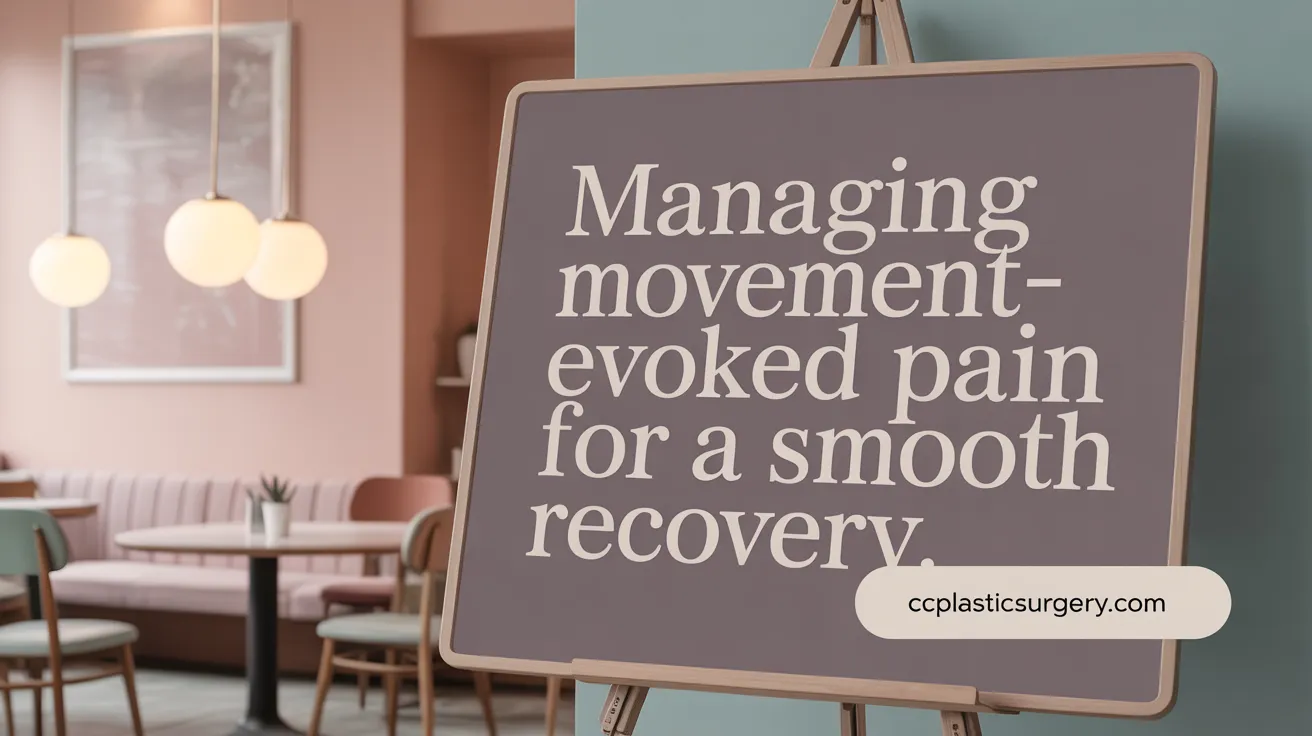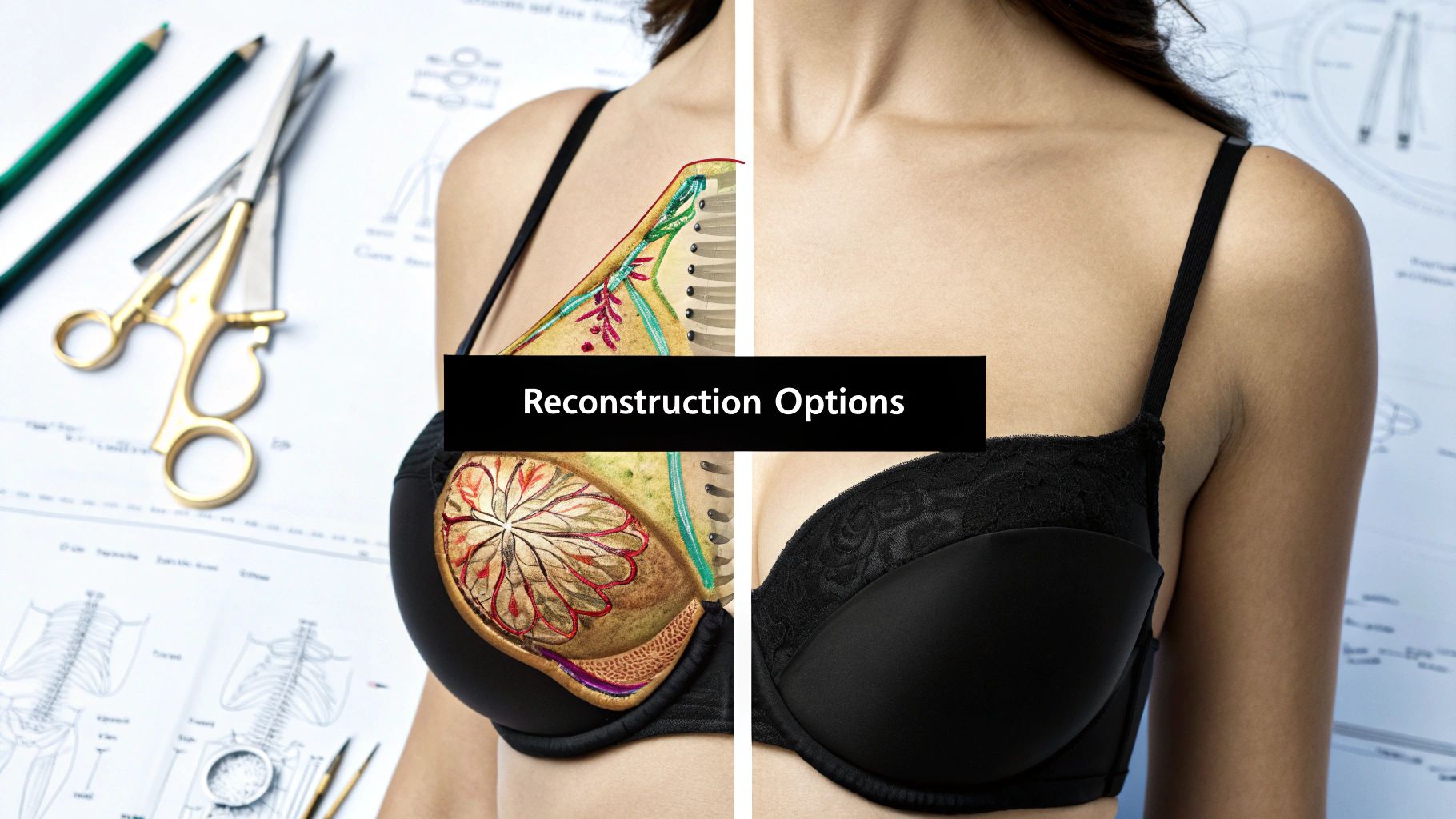
November 16, 2025
How to Finance Cosmetic Surgery Your Smart Guide
Discover how to finance cosmetic surgery with our guide. Explore personal loans, medical credit cards, and payment plans to make your goals a reality.
Oct 1, 2025

Navigating the journey of recovery after surgery hinges greatly on understanding and managing pain effectively. Post-surgical pain is a complex, multifaceted phenomenon influenced by the type of surgery, individual patient factors, and the adequacy of pain control strategies. Recognizing the kinds of pain experienced, their causes, and implications is foundational to achieving optimal healing and regaining function. This article explores evidence-based approaches to pain management, the critical role of physical therapy, emotional well-being, patient education, and comprehensive care strategies that together foster faster and safer recovery.

Post-surgical pain can be broadly categorized into two main types: acute and chronic. Acute pain occurs immediately following surgery, is usually localized, and tends to resolve with proper management and tissue healing. Chronic pain persists beyond three months after the surgical procedure and may result from nerve injury, abnormal nerve regeneration, or changes in the central nervous system that lead to heightened pain sensitivity.
The underlying causes of post-surgical pain include tissue damage and inflammation caused by the surgical incision and manipulation, nerve injury from cutting or compression, and strain on muscles and joints. Internal organ involvement, depending on the surgery, can also contribute to discomfort. Neuropathic pain, characterized by sensations such as burning, shooting, or tingling, often results from nerve cell damage during surgery.
Different surgical procedures produce varying pain profiles. For example, invasive surgeries like joint replacements may lead to more severe somatic pain, whereas abdominal surgeries can cause visceral pain. Additionally, surgeries involving nerve structures might cause neuropathic pain, which can be complex to treat.
Effective pain control is essential not only for comfort but also to prevent the transition from acute to chronic pain. Managing acute pain proactively with multimodal strategies—combining medications, nerve blocks, and physical therapies—helps achieve early mobility, reduces psychological distress, and minimizes the risk of long-term pain complications.
In summary, recognizing the types and causes of post-surgical pain is fundamental to crafting appropriate treatment plans. Tailoring interventions to the specific pain profile and surgical context supports better recovery outcomes and enhances patient well-being.

Managing pain effectively after surgery involves a blend of approaches that target various aspects of discomfort, supporting better healing and faster recovery. One of the most effective methods is multimodal pain management, which combines medicines and therapies to optimize results while minimizing side effects.
Pharmacological options include medications such as opioids, NSAIDs, acetaminophen, local anesthetics, and regional anesthesia techniques like nerve blocks and epidurals. These drugs work by reducing pain signals and inflammation at different levels. For example, regional anesthesia can block nerve signals to broader areas of the body, providing targeted relief. On the other hand, non-pharmacological therapies play a crucial role in addressing the emotional and physical components of pain.
Non-drug approaches include preoperative education, acupuncture, massage, relaxation techniques, cognitive-behavioral therapy, and guided imagery. These methods help reduce anxiety, improve emotional well-being, and empower patients in their recovery. Physical therapy activities, such as gentle movement and stretching, enhance mobility and decrease stiffness, further reducing pain.
Preoperative education is especially important. Using standardized tools like the ACS SEPCAS brochure, patients learn to recognize overdose signs, dispose of medications safely, and understand their pain management plan. This knowledge diminishes anxiety, decreases unnecessary opioid use, and promotes safer practices.
Combining pharmacological and non-pharmacological strategies creates a comprehensive pain management plan tailored to each patient. Regular assessment of pain levels using standardized scales allows healthcare providers to adjust treatments efficiently, ensuring optimal control.
The integration of these approaches, supported by protocols like Enhanced Recovery After Surgery (ERAS), leads to fewer complications, quicker mobilization, and improved overall patient satisfaction. With continuous evaluation and personalized care, effective pain management becomes an achievable goal that supports quicker healing and better long-term outcomes.
| Strategy Type | Examples | Benefits | Additional Notes |
|---|---|---|---|
| Pharmacologic | Opioids, NSAIDs, acetaminophen, local anesthetics | Direct pain relief, inflammation reduction | Used in conjunction with other therapies |
| Regional techniques | Nerve blocks, epidural analgesia | Targeted relief, reduced systemic side effects | Require skilled practitioners |
| Non-pharmacologic | Education, acupuncture, massage, relaxation, CBT | Reduce anxiety, improve mood, support healing | Cost-effective and fewer side effects |
| Physical therapy | Exercises, manual therapy, mobility training | Restore movement, decrease stiffness | Essential for functional recovery |
Effective pain management in postoperative care involves ongoing adjustments, with continuous assessment guiding therapy modifications. This ensures each patient receives personalized, safe, and effective relief, ultimately supporting a smoother and quicker recovery process.

Postoperative physical therapy and exercises are essential components of recovery, helping to promote healing and restore function. They support circulation, which delivers vital nutrients and oxygen to tissues, accelerating tissue repair.
Physical therapy also helps reduce stiffness, prevent muscle atrophy, and improve joint mobility. Tailored programs guide patients through a variety of exercises including range of motion, stretching, strengthening, and balance training.
During the initial phase, gentle movements such as ankle pumps, isometric exercises, and light range of motion activities are introduced. These exercises are designed to minimize congestion and encourage early tissue healing.
As patients progress, more active exercises focusing on rebuilding strength and functional movements are incorporated. This might include resistance training, weight-bearing activities, and task-specific exercises aimed at everyday tasks.
The phased approach ensures that healing is supported safely while preventing complications like stiffness or muscle wasting. Each stage of rehabilitation emphasizes personalized plans based on the type of surgery and patient needs.
Rehabilitation starts immediately after surgery and unfolds over several stages:
| Phase | Duration | Focus | Typical Activities |
|---|---|---|---|
| Immediate postoperative | 1-7 days | Reduce pain, prevent blood clots, initiate gentle movement | Ankle pumps, breathing exercises, light range of motion |
| Early rehabilitation | Weeks 1-4 | Improve mobility, reduce stiffness | Guided stretching, strengthening exercises, walking with assistance |
| Intermediate rehab | Weeks 4-8 | Restore strength, enhance endurance | Resistance exercises, functional tasks, balance activities |
| Advanced rehab | Weeks 8+ | Return to normal activity, sports-specific drills | Advanced strength, plyometrics, sport or activity-specific training |
Every patient’s journey is unique. Therapists develop customized plans based on the surgical procedure, overall health, and specific goals. Education is a vital part of therapy, teaching patients about proper movement, precautions, and home exercises.
This personalized approach reduces risk, enhances motivation, and maximizes recovery outcomes. Patients who understand their exercises and the importance of adherence tend to regain mobility and strength more effectively.
Proper physical therapy reduces pain by improving circulation and reducing muscle tension. As mobility improves, patients experience less discomfort and are more likely to move actively, which further aids healing.
Maximizing function involves regaining strength, flexibility, coordination, and confidence in movement. This comprehensive approach supports the goals of returning to daily activities, work, and recreational pursuits.
| Benefits of Physical Therapy | Impact on Recovery | Specific Techniques |
|---|---|---|
| Accelerates tissue healing | Quicker return to normal activities | Manual therapy, electrical stimulation |
| Reduces stiffness and pain | Fewer complications | Range of motion exercises, thermal therapies |
| Restores muscle strength | Prevents muscle atrophy | Resistance training, functional exercises |
| Enhances joint mobility | Better quality of movement | Stretching, balance training |
| Promotes confidence and independence | Improved psychological well-being | Education, activity planning |

Movement-evoked pain refers to pain initiated or worsened by active or passive movement of tissues involved in surgery. It is a common experience in both acute and chronic postoperative states. Studies indicate that approximately 75% of patients encounter significant movement-related discomfort after surgery, which can hinder early mobilization and prolong recovery.
Severe movement-evoked pain can be immobilizing, discouraging patients from engaging in necessary physical activity. This activity avoidance can lead to complications such as blood clots, pneumonia, and joint stiffness, ultimately delaying tissue healing and reducing functional independence. Addressing this pain effectively is crucial to promote early movement and optimal recovery.
A comprehensive approach combines pharmacologic and non-pharmacologic therapies. Pharmacologically, options include topical analgesics, NSAIDs, acetaminophen, regional anesthesia (like nerve blocks), and carefully managed opioids when necessary.
Non-pharmacologic methods encompass positioning, thermotherapy, massage, guided relaxation, and graded exercises. Regular assessment of pain at rest and during movement helps tailor these therapies, aiming to minimize discomfort and facilitate early mobility.
Educating patients about the nature of postoperative MEP, expected discomfort levels, and realistic activity goals helps set positive expectations. Understanding that some pain should diminish with continued activity encourages active participation and reduces psychological barriers like fear of pain, which can impede recovery.
Effective management depends on thorough assessment of pain severity, location, and impact on function. Implementing SMART (Specific, Measurable, Achievable, Relevant, Time-bound) goals drives personalized interventions, improving adherence and outcomes. Continuous re-evaluation allows healthcare teams to adjust therapy plans, ensuring the effectiveness of pain control strategies.
This integrated, individualized approach supports not only pain reduction but also enhances mobility, accelerates healing, and minimizes complications—creating a foundation for a smooth postoperative recovery process.

Emotional health significantly impacts how patients recover from surgery and perceive pain. Positive mental states, such as hope and resilience, can boost the immune system, promote better blood flow, and facilitate faster wound healing. When patients experience feelings of happiness and social support, they often report less pain and discomfort.
Conversely, negative emotions such as anxiety, depression, and stress can hinder recovery. These feelings may heighten pain perception, increase inflammation, and weaken immune responses, leading to prolonged healing times. Stress and fear can also reduce motivation to engage in necessary rehabilitation activities, like movement and physical therapy, which are vital for optimal recovery.
Psychological interventions like cognitive-behavioral therapy (CBT), mindfulness meditation, and relaxation techniques help address emotional challenges. These practices can decrease anxiety levels, improve mood, and promote a sense of control during the recovery process.
Maintaining social connections and fostering a positive outlook are essential strategies to support emotional well-being post-surgery. Encouraging patients to seek emotional support, stay engaged with loved ones, and practice mental exercises can empower them to adhere to treatment plans and participate actively in their healing journey.
In summary, addressing emotional health is integral to effective pain management and recovery. By nurturing a positive psychological environment, patients can experience less pain, fewer complications, and ultimately achieve better health outcomes after surgery.
Educating patients before and after surgery plays a vital role in effective pain management. When patients understand their pain, available treatment options, and proper medication use, they are more likely to follow prescribed regimens correctly. This knowledge reduces the risk of medication misuse, particularly opioids, and helps patients recognize signs of complications such as increased pain, fever, or nausea.
Preoperative discussions about pain expectations and management strategies can decrease anxiety, improve satisfaction, and lead to better recovery outcomes. These sessions often include information about non-drug therapies like heat, ice, massage, and relaxation techniques, which can complement medications.
Effective communication methods such as visual aids, educational videos, and teach-back techniques ensure patients truly understand essential instructions, including how to store and dispose of medications safely. Patients who are well-informed can participate actively in their care, adhere to rehabilitation protocols, and avoid unnecessary complications.
Overall, patient education addresses common barriers in pain management, leading to safer, more personalized, and more successful recovery experiences.
Effective recovery harnesses a combination of wound management, pain control, and early activity. Proper wound care prevents infections, while managing pain allows patient comfort and encourages movement. Initiating gentle walking and mobility exercises soon after surgery reduces risks such as blood clots and pneumonia.
Getting moving early helps improve circulation, maintain muscle strength, and prevent complications like deep vein thrombosis and respiratory issues. Patients are encouraged to perform guided activities, such as ankle rotations, leg slides, and gentle stretching, which promote tissue healing and restore functional movement.
A nutritious diet rich in protein, vitamins (like C and B12), minerals (iron), and fiber supports tissue repair and immune function. Staying well-hydrated and consuming fiber also prevents constipation, a common postoperative issue. Incorporating probiotics can further enhance gut health, which is vital for overall healing.
Following surgeon’s guidelines on activity restrictions, medication schedules, and hygiene is critical. Attending scheduled follow-up appointments helps monitor progress and prevent complications. Avoiding smoking and alcohol improves circulation and speeds up recovery.
A team approach involving surgeons, nurses, physical therapists, and nutritionists ensures comprehensive support. This collaboration helps tailor rehabilitation and identify potential issues early, allowing adjustments that optimize outcomes.
| Practice Area | Overview | Additional Details |
|---|---|---|
| Wound management | Prevents infections, supports tissue healing | Proper cleaning, dressing changes, hygiene practices |
| Pain control | Promotes mobility, reduces psychological distress | Medications, physical methods, relaxation techniques |
| Early mobilization | Reduces complications, restores function | Walking, guided exercises, assistive device use |
| Nutritional support | Enhances tissue repair, immune response | Protein, vitamins, hydration, probiotics |
| Follow-up and adherence | Ensures progress monitoring, complication prevention | Appointments, activity instructions, lifestyle modifications |
| Multidisciplinary approach | Provides holistic care, addresses physical and psychological needs | Coordination among healthcare providers |
Adopting these practices enriches the postoperative experience, fostering faster healing and a return to normal activities in the safest, most effective manner.
Successful post-surgical recovery is a multidimensional process that hinges on effective pain management, physical rehabilitation, emotional support, patient empowerment, and adherence to best care practices. Understanding the types and causes of post-surgical pain lays the foundation for comprehensive, multimodal strategies tailored to individual needs. Combining pharmacologic and non-pharmacologic approaches enhances pain relief and minimizes risks associated with opioid use. Physical therapies play a crucial role in restoring mobility and function, while attention to emotional well-being supports overall healing. Education equips patients to participate actively and safely in their recovery journey. Finally, implementing evidence-based best practices in a coordinated, multidisciplinary context fosters faster, safer, and more satisfying recovery outcomes, ultimately helping patients regain their quality of life and daily function after surgery.

November 16, 2025
Discover how to finance cosmetic surgery with our guide. Explore personal loans, medical credit cards, and payment plans to make your goals a reality.

November 15, 2025
Learn the questions to ask cosmetic surgeon before your procedure to ensure safety, align expectations, and achieve the best results.

November 14, 2025
Discover breast reconstruction options after mastectomy: implants vs flap, timing, and recovery tips to help you decide.